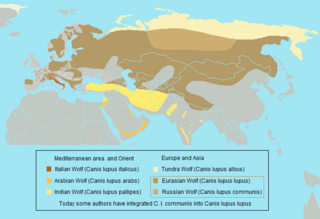A Special Area of Conservation (SAC) is defined in the European Union's Habitats Directive (92/43/EEC), also known as the Directive on the Conservation of Natural Habitats and of Wild Fauna and Flora. They are to protect the 220 habitats and approximately 1,000 species listed in annex I and II of the directive which are considered to be of European interest following criteria given in the directive. They must be chosen from the Sites of Community Importance by the member states and designated SAC by an act assuring the conservation measures of the natural habitat.

Abies nebrodensis, the Sicilian fir, is a fir native to the Madonie mountains in northern Sicily.

The conservation status of a group of organisms indicates whether the group still exists and how likely the group is to become extinct in the near future. Many factors are taken into account when assessing conservation status: not simply the number of individuals remaining, but the overall increase or decrease in the population over time, breeding success rates, and known threats. Various systems of conservation status exist and are in use at international, multi-country, national and local levels as well as for consumer use.

Marsupella profunda, the western rustwort, is a liverwort native to Europe and known only from Portugal and Great Britain (Cornwall) and has been sighted in the Canary Islands. It is a small reddish liverwort and can be confused with Marsupella sprucei which has a more widespread distribution.
The Habitats Directive is a directive adopted by the European Community in 1992 as a response to the Berne Convention. The European Community was reformed as the European Union the following year, but the directive is still recognised.

Desmoulin's whorl snail is a species of minute air-breathing land snail, a terrestrial pulmonate gastropod mollusc or micromollusc in the family Vertiginidae, the whorl snails.
A Site of Community Importance (SCI) is defined in the European Commission Habitats Directive (92/43/EEC) as a site which, in the biogeographical region or regions to which it belongs, contributes significantly to the maintenance or restoration at a favourable conservation status of a natural habitat type or of a species and may also contribute significantly to the coherence of Natura 2000, and/or contributes significantly to the maintenance of biological diversity within the biogeographic region or regions concerned.

Apium bermejoi is a critically endangered species of flowering plant in the family Apiaceae.
Bupleurum kakiskalae is a species of flowering plant in the family Apiaceae. It is endemic to western Crete, an island which is part of Greece.
Naufraga balearica is an extremely species of flowering plant in the family Apiaceae, and the only species in the monotypic genus Naufraga. It is endemic to the Spanish island of Majorca, where it is found only at the base of cliffs at the north of the island near Pollença. A population was discovered on Corsica in 1981, but it had died out by 1983, and it is not clear whether it arrived naturally. Its natural habitats are Mediterranean-type shrubby vegetation and rocky shores.

Picconia azorica is an endemic species of Picconia, common to majority of the islands of the Portuguese archipelago of the Azores, locally referred to as pau-branco, it is threatened by habitat loss.

Ophrys lunulata, the moon orchid, is a species of orchid native to the islands of Malta and Sicily in the central Mediterranean.
The Cantabrian capercaillie is a subspecies of the western capercaillie in the grouse family Tetraonidae. It is one of two subspecies found in Spain.

Leopoldia gussonei is a plant in the family Asparagaceae, endemic to the Island of Sicily.

Galium litorale is a rare species of bedstraw in the Rubiaceae family. It is endemic to the island of Sicily in the Mediterranean Sea. In Italian it is known as caglio costiero.

Narcissus nevadensis is a species of the genus Narcissus (daffodils) in the family Amaryllidaceae. It is classified in Section Nevadensis. It is native to the Baetic System in Spain. It is considered an endangered species. In 1992 it was designated as a 'priority species' under Annex II of the Habitats Directive in the European Union, which means areas in which it occurs can be declared Special Areas of Conservation, if these areas belong to one of the number of habitats listed in Annex I of the directive.

Centaurea horrida is a species of the genus Centaurea which is only found growing in Sardinia and associated islands. Due to their limited ability to disperse, they are isolated from other environments, and have a very low colonizing ability.

The Anatolian crested newt is a newt species endemic to northern Anatolia in Turkey. Before its description in 2016, it was first considered to belong to the southern crested newt and then the Balkan crested newt. The three species form a complex of morphologically indistinguishable cryptic species. Genetic data demonstrated the Anatolian crested newt to be distinct from the other two species, although it hybridises with the Balkan crested newt at its western range end.
Daphne rodriguezii is a shrub, of the family Thymelaeaceae. It is endemic to Menorca, one of the Balearic Islands that belongs to Spain.

The favourable conservation status of wolves is the definition of a wolf population that is no longer threatened with extinction, that is capable of long-term survival. In Europe the favourable conservation status is defined by the Guidelines for Population Level Management Plans for Large Carnivores. It is the minimum viable population, that can be of different numbers of wolves depending on their connectivity with neighbouring populations.














